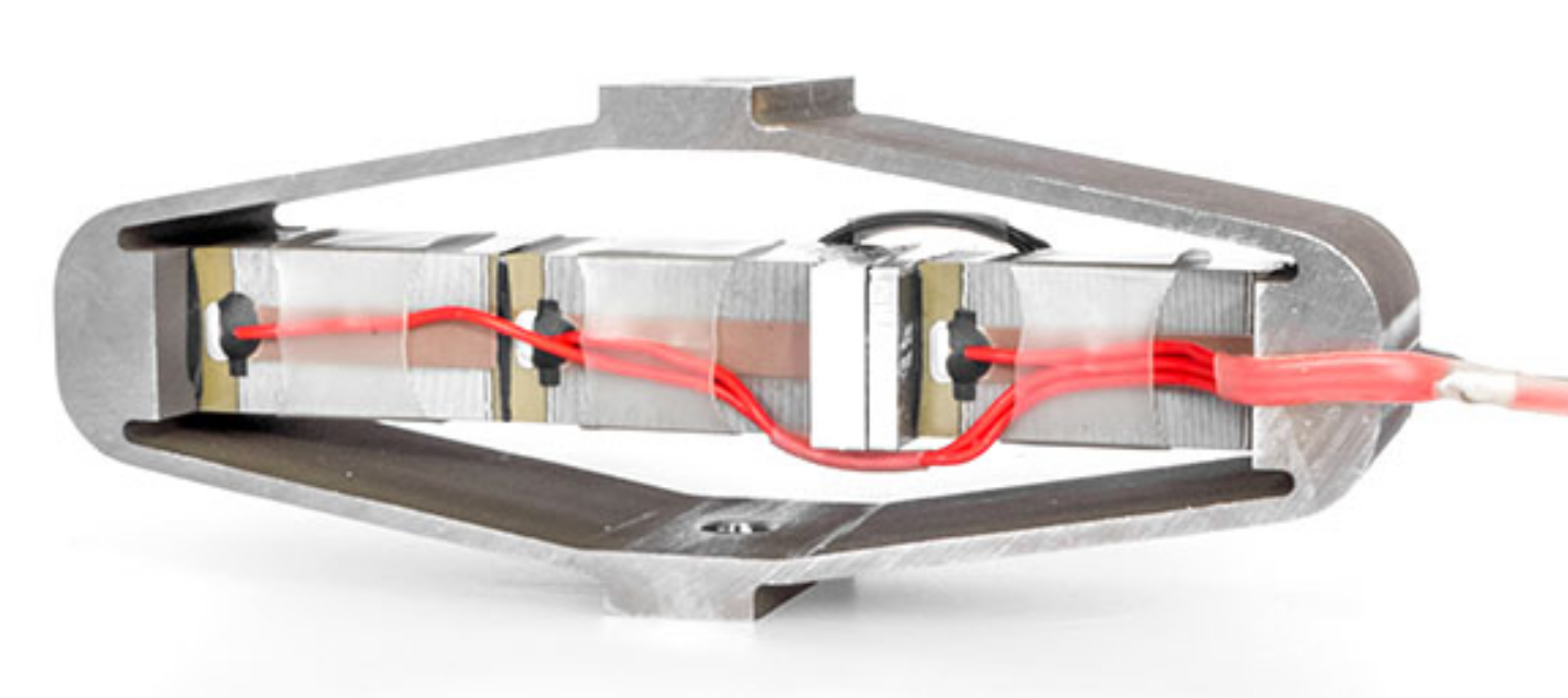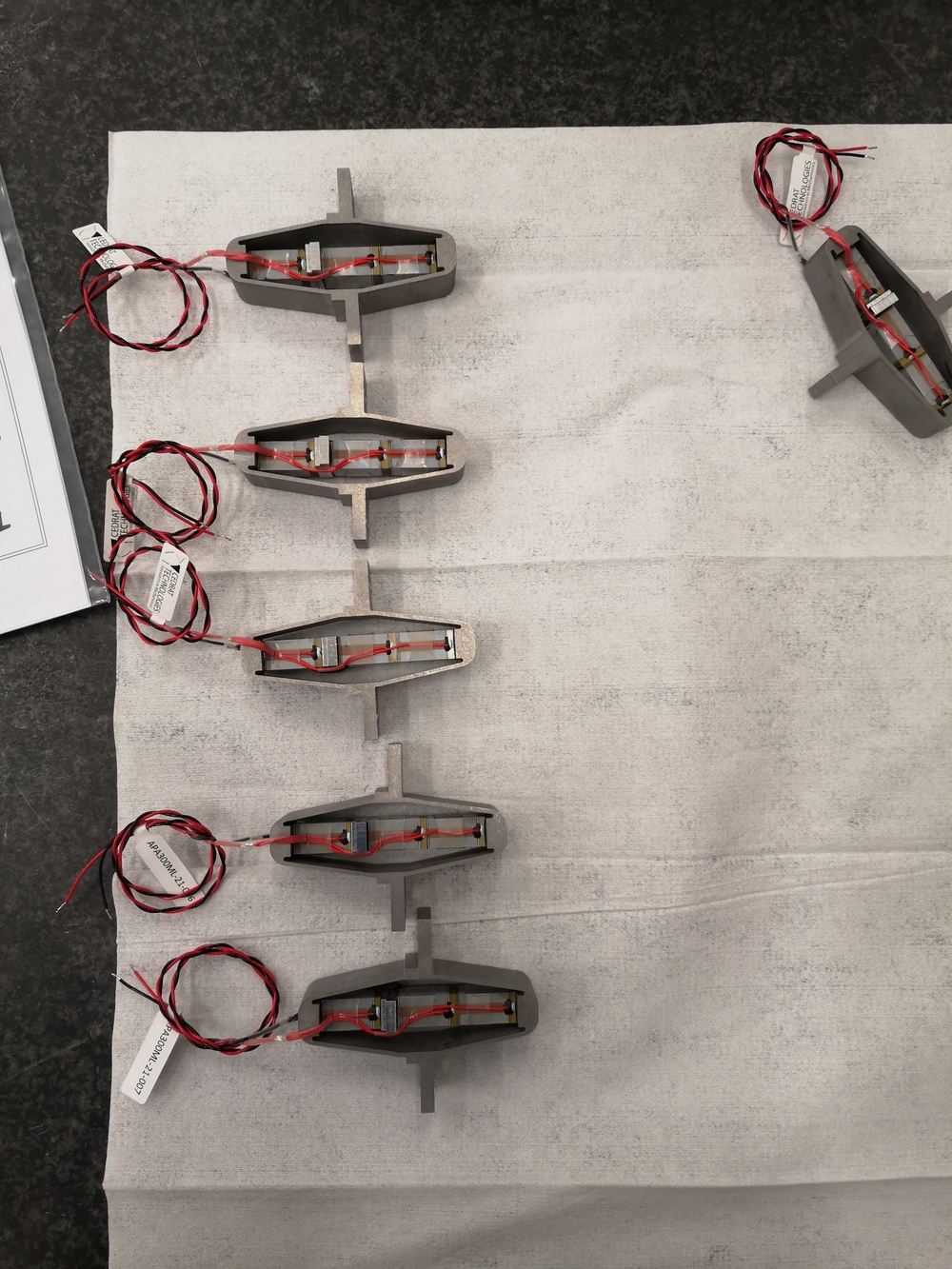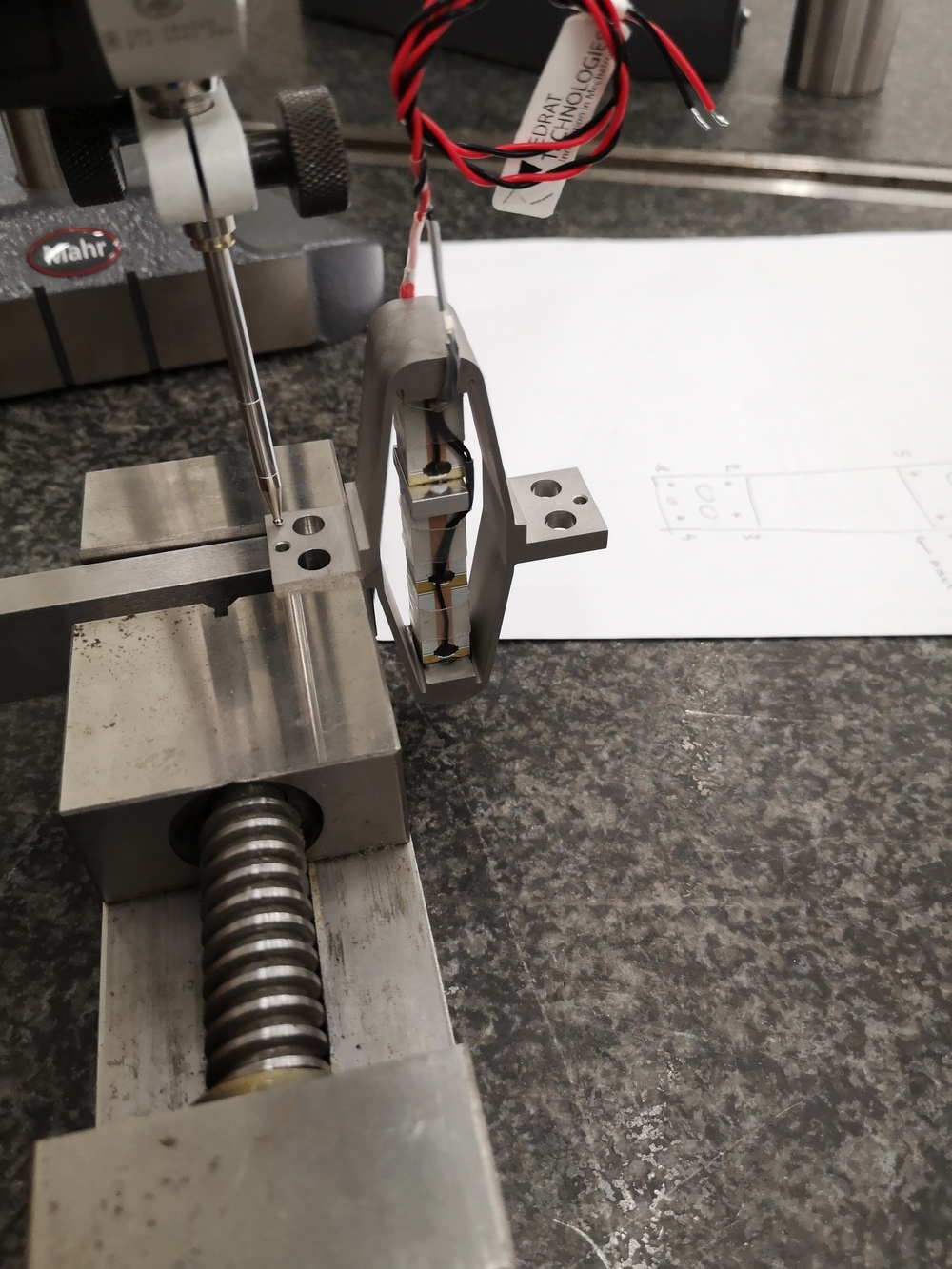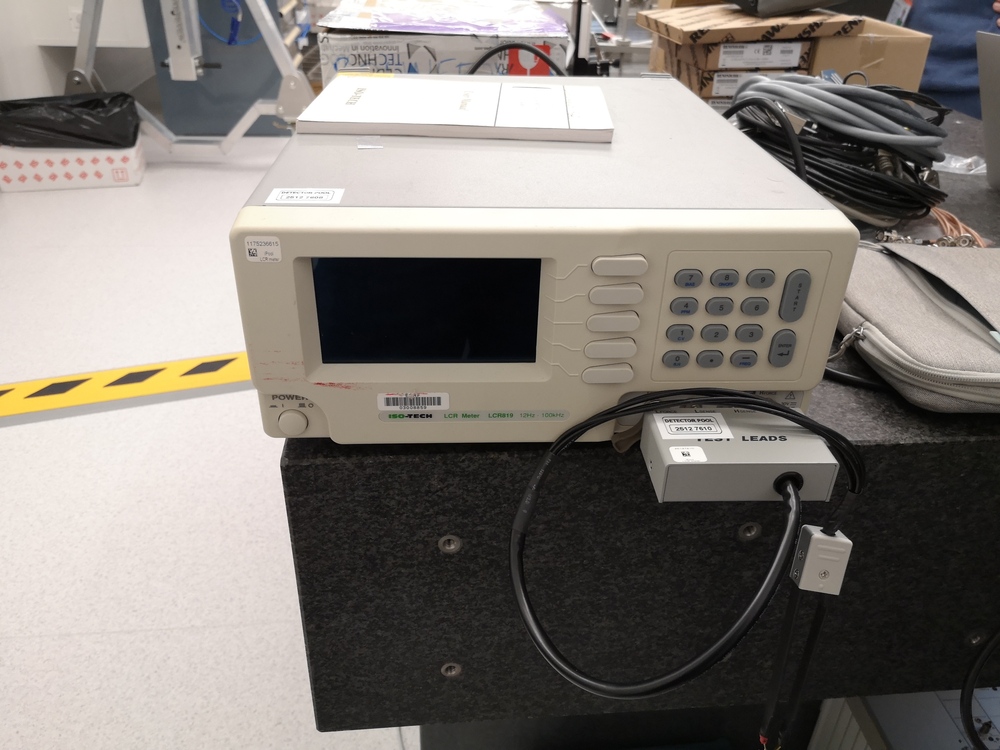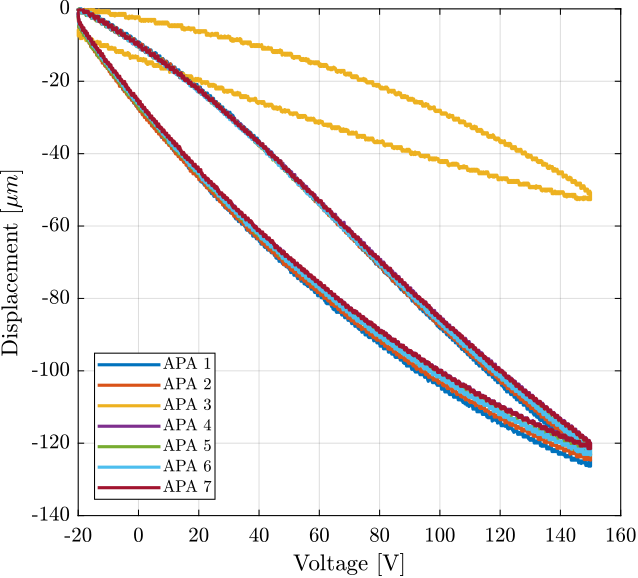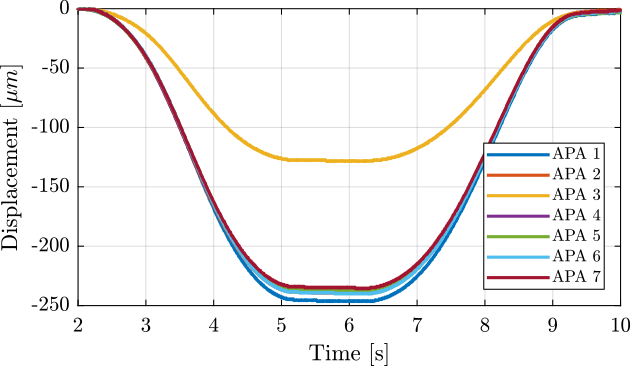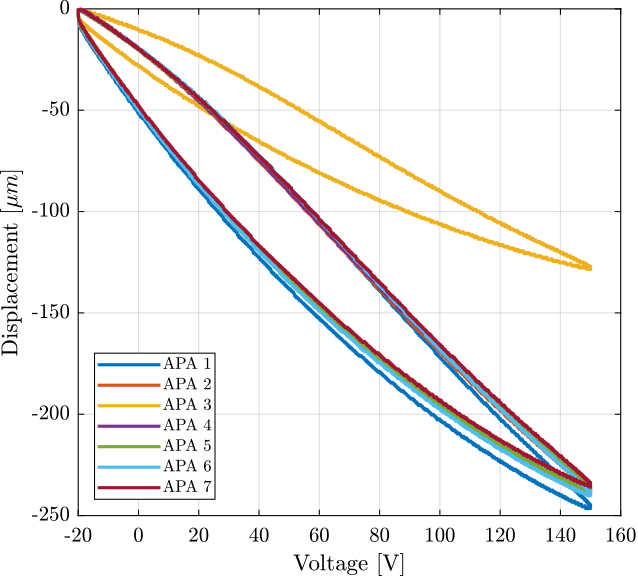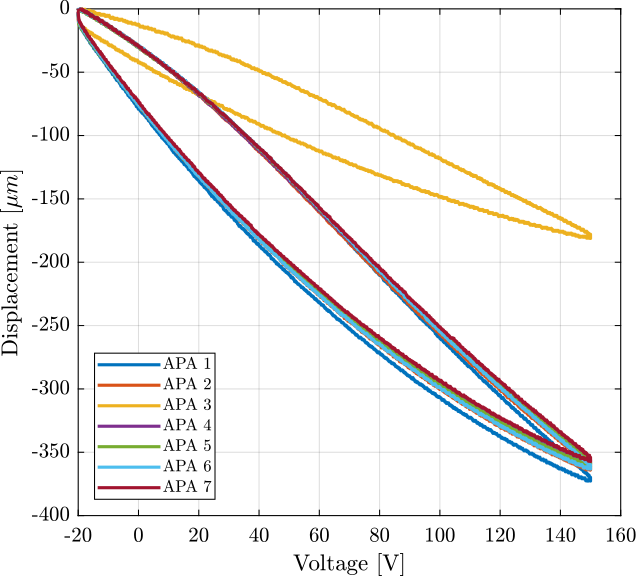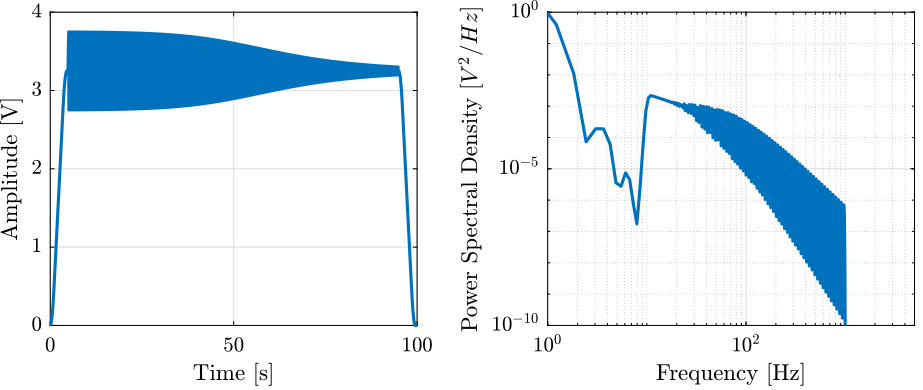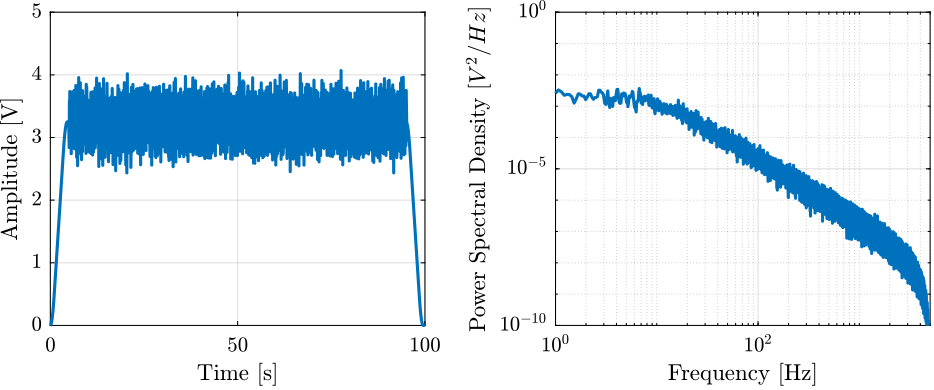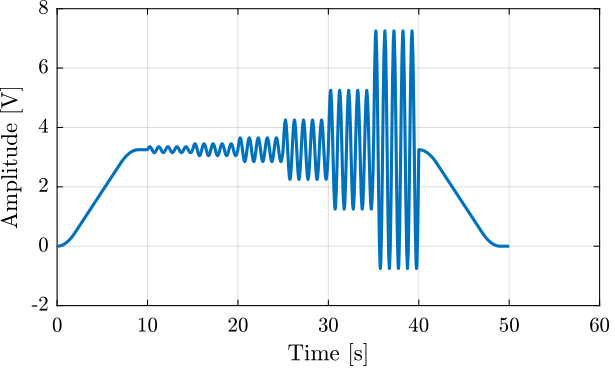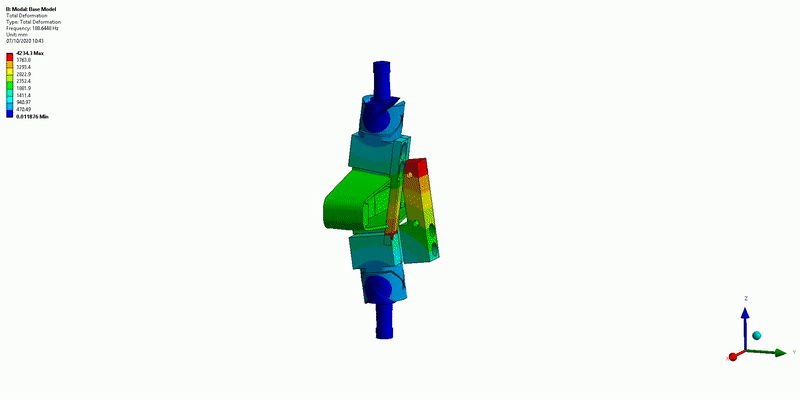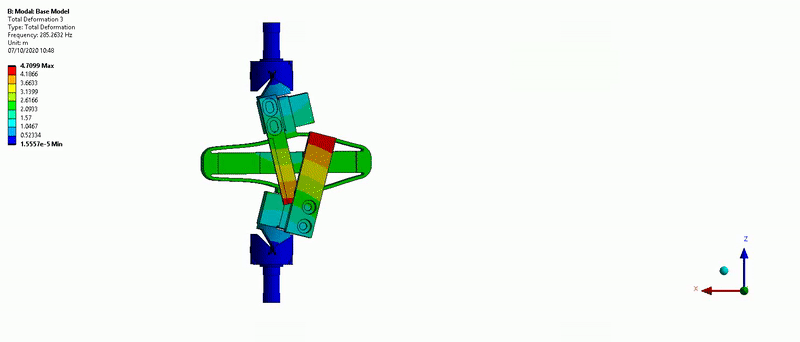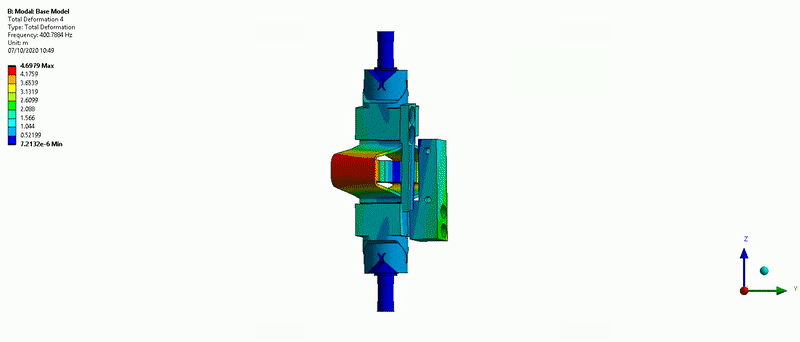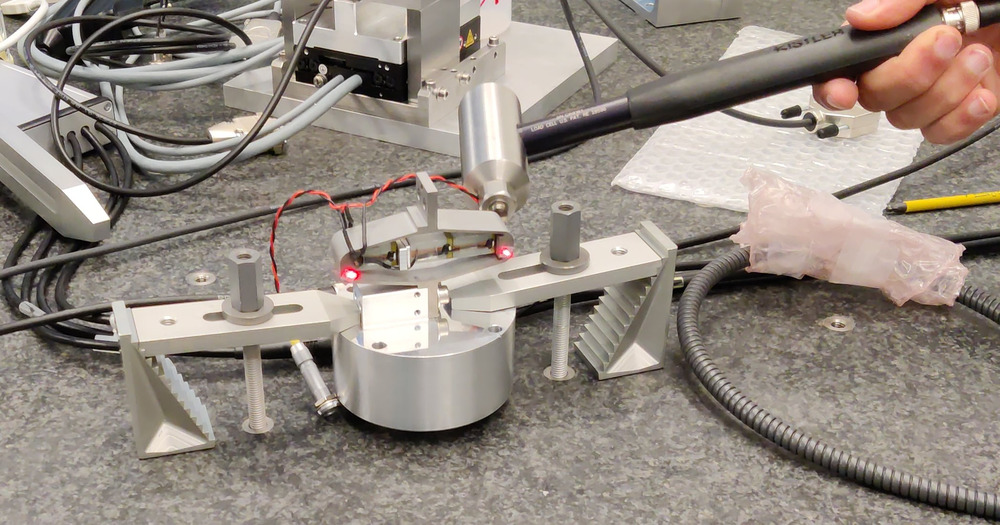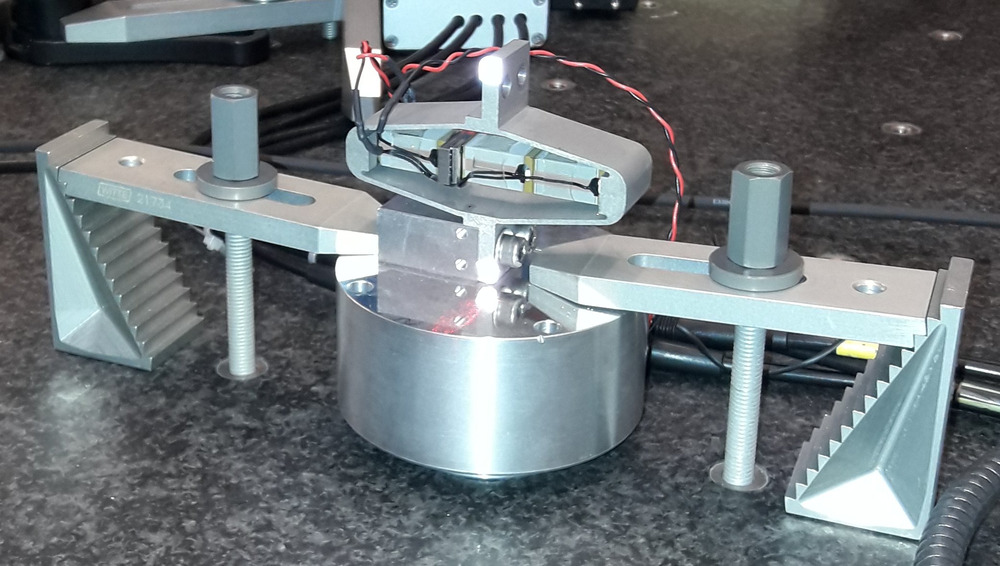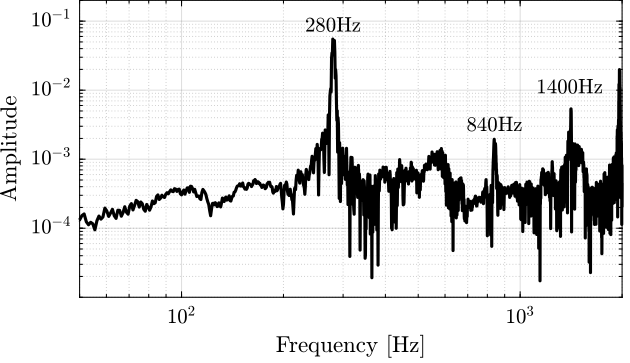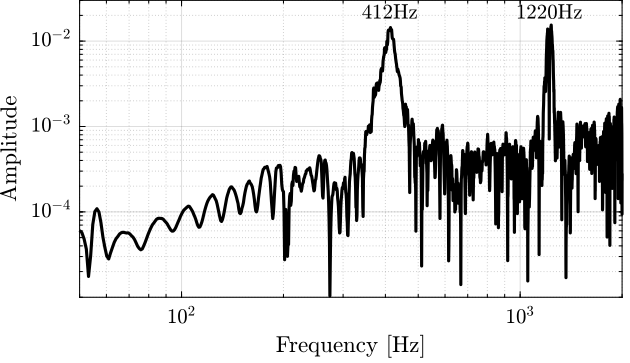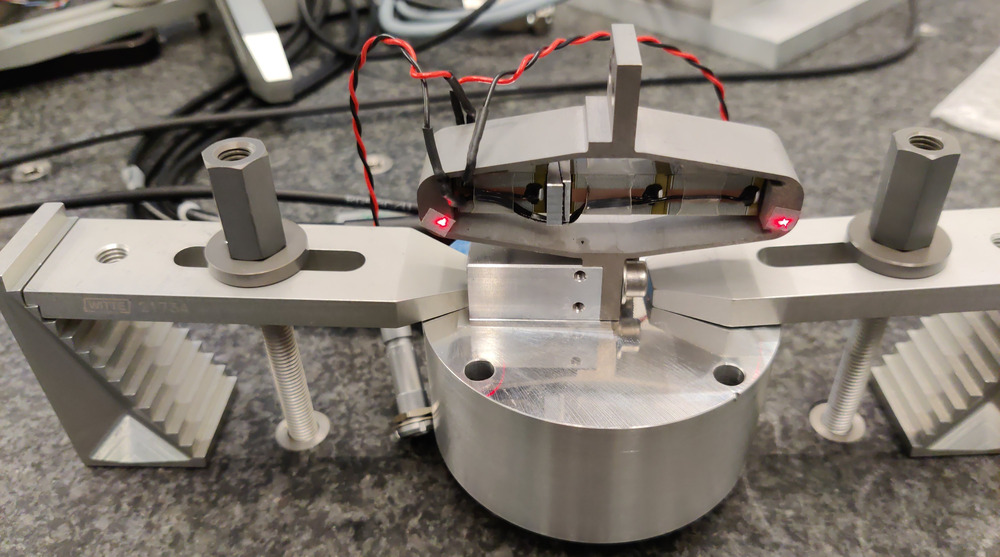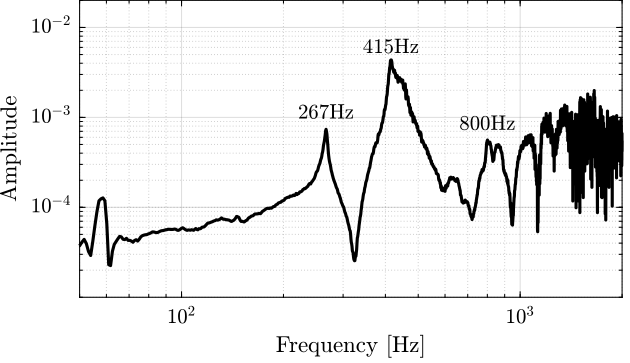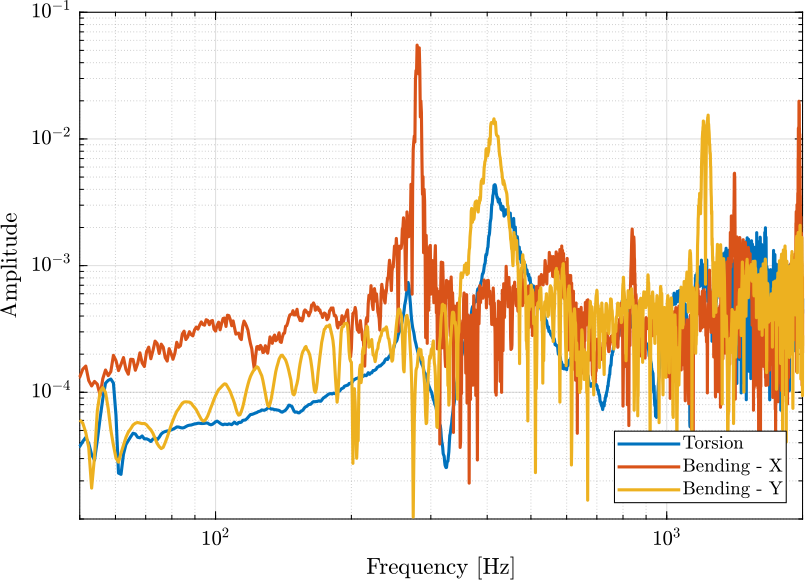111 KiB
Amplifier Piezoelectric Actuator APA300ML - Test Bench
- Introduction
- Model of an Amplified Piezoelectric Actuator and Sensor
- Geometrical Measurements
- Electrical Measurements
- Stroke measurement
- Stiffness measurement
- Test-Bench Description
- Measurement Procedure
- FRF measurement
- Measurement Results
- Test Bench APA300ML - Simscape Model
- Test Bench Struts - Simscape Model
- Resonance frequencies - APA300ML
- Function
- Bibliography
This report is also available as a pdf.
Introduction ignore
The goal of this test bench is to extract all the important parameters of the Amplified Piezoelectric Actuator APA300ML.
This include:
- Stroke
- Stiffness
- Hysteresis
- Gain from the applied voltage $V_a$ to the generated Force $F_a$
- Gain from the sensor stack strain $\delta L$ to the generated voltage $V_s$
- Dynamical behavior
Model of an Amplified Piezoelectric Actuator and Sensor
Consider a schematic of the Amplified Piezoelectric Actuator in Figure fig:apa_model_schematic.
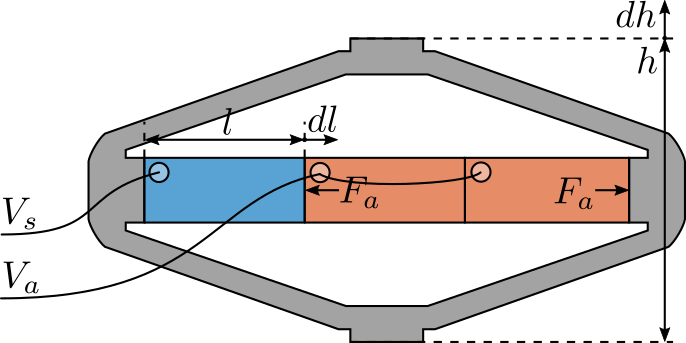
A voltage $V_a$ applied to the actuator stacks will induce an actuator force $F_a$:
\begin{equation} F_a = g_a \cdot V_a \end{equation}A change of length $dl$ of the sensor stack will induce a voltage $V_s$:
\begin{equation} V_s = g_s \cdot dl \end{equation}We wish here to experimental measure $g_a$ and $g_s$.
The block-diagram model of the piezoelectric actuator is then as shown in Figure fig:apa-model-simscape-schematic.
\begin{tikzpicture}
\node[block={2.0cm}{2.0cm}, align=center] (model) at (0,0){Simscape\\Model};
\node[block, left=1.0 of model] (ga){$g_a(s)$};
\node[block, right=1.0 of model] (gs){$g_s(s)$};
\draw[<-] (ga.west) -- node[midway, above]{$V_a$} node[midway, below]{$[V]$} ++(-1.0, 0);
\draw[->] (ga.east) --node[midway, above]{$F_a$} node[midway, below]{$[N]$} (model.west);
\draw[->] (model.east) --node[midway, above]{$dl$} node[midway, below]{$[m]$} (gs.west);
\draw[->] (gs.east) -- node[midway, above]{$V_s$} node[midway, below]{$[V]$} ++(1.0, 0);
\end{tikzpicture}Geometrical Measurements
Introduction ignore
The received APA are shown in Figure fig:received_apa.
Measurement Setup
The flatness corresponding to the two interface planes are measured as shown in Figure fig:flatness_meas_setup.
Measurement Results
The height (Z) measurements at the 8 locations (4 points by plane) are defined below.
apa1 = 1e-6*[0, -0.5 , 3.5 , 3.5 , 42 , 45.5, 52.5 , 46];
apa2 = 1e-6*[0, -2.5 , -3 , 0 , -1.5 , 1 , -2 , -4];
apa3 = 1e-6*[0, -1.5 , 15 , 17.5 , 6.5 , 6.5 , 21 , 23];
apa4 = 1e-6*[0, 6.5 , 14.5 , 9 , 16 , 22 , 29.5 , 21];
apa5 = 1e-6*[0, -12.5, 16.5 , 28.5 , -43 , -52 , -22.5, -13.5];
apa6 = 1e-6*[0, -8 , -2 , 5 , -57.5, -62 , -55.5, -52.5];
apa7 = 1e-6*[0, 19.5 , -8 , -29.5, 75 , 97.5, 70 , 48];
apa7b = 1e-6*[0, 9 , -18.5, -30 , 31 , 46.5, 16.5 , 7.5];
apa = {apa1, apa2, apa3, apa4, apa5, apa6, apa7b};The X/Y Positions of the 8 measurement points are defined below.
W = 20e-3; % Width [m]
L = 61e-3; % Length [m]
d = 1e-3; % Distance from border [m]
l = 15.5e-3; % [m]
pos = [[-L/2 + d; W/2 - d], [-L/2 + l - d; W/2 - d], [-L/2 + l - d; -W/2 + d], [-L/2 + d; -W/2 + d], [L/2 - l + d; W/2 - d], [L/2 - d; W/2 - d], [L/2 - d; -W/2 + d], [L/2 - l + d; -W/2 + d]];
Finally, the flatness is estimated by fitting a plane through the 8 points using the fminsearch command.
apa_d = zeros(1, 7);
for i = 1:7
fun = @(x)max(abs(([pos; apa{i}]-[0;0;x(1)])'*([x(2:3);1]/norm([x(2:3);1]))));
x0 = [0;0;0];
[x, min_d] = fminsearch(fun,x0);
apa_d(i) = min_d;
endThe obtained flatness are shown in Table tab:flatness_meas.
| Flatness $[\mu m]$ | |
|---|---|
| APA 1 | 8.9 |
| APA 2 | 3.1 |
| APA 3 | 9.1 |
| APA 4 | 3.0 |
| APA 5 | 1.9 |
| APA 6 | 7.1 |
| APA 7 | 18.7 |
Electrical Measurements
The capacitance of the stacks is measure with the LCR-800 Meter (doc)
The excitation frequency is set to be 1kHz.
| Sensor Stack | Actuator Stacks | |
|---|---|---|
| APA 1 | 5.10 | 10.03 |
| APA 2 | 4.99 | 9.85 |
| APA 3 | 1.72 | 5.18 |
| APA 4 | 4.94 | 9.82 |
| APA 5 | 4.90 | 9.66 |
| APA 6 | 4.99 | 9.91 |
| APA 7 | 4.85 | 9.85 |
There is clearly a problem with APA300ML number 3
Stroke measurement
Introduction ignore
We here wish to estimate the stroke of the APA.
To do so, one side of the APA is fixed, and a displacement probe is located on the other side as shown in Figure fig:stroke_test_bench.
Then, a voltage is applied on either one or two stacks using a DAC and a voltage amplifier.
Here are the documentation of the equipment used for this test bench:
- Voltage Amplifier: PD200 with a gain of 20
- 16bits DAC: IO313 Speedgoat card
- Displacement Probe: Millimar C1216 electronics and Millimar 1318 probe
Voltage applied on one stack
Let's first look at the relation between the voltage applied to one stack to the displacement of the APA as measured by the displacement probe.
The applied voltage is shown in Figure fig:apa_stroke_voltage_time.
The obtained displacement is shown in Figure fig:apa_stroke_time_1s. The displacement is set to zero at initial time when the voltage applied is -20V.
Finally, the displacement is shown as a function of the applied voltage in Figure fig:apa_d_vs_V_1s. We can clearly see that there is a problem with the APA 3. Also, there is a large hysteresis.
We can clearly see from Figure fig:apa_d_vs_V_1s that there is a problem with the APA number 3.
Voltage applied on two stacks
Now look at the relation between the voltage applied to the two other stacks to the displacement of the APA as measured by the displacement probe.
The obtained displacement is shown in Figure fig:apa_stroke_time_2s. The displacement is set to zero at initial time when the voltage applied is -20V.
Finally, the displacement is shown as a function of the applied voltage in Figure fig:apa_d_vs_V_2s. We can clearly see that there is a problem with the APA 3. Also, there is a large hysteresis.
Voltage applied on all three stacks
Finally, we can combine the two measurements to estimate the relation between the displacement and the voltage applied to the three stacks (Figure fig:apa_d_vs_V_3s).
The obtained maximum stroke for all the APA are summarized in Table tab:apa_measured_stroke.
| Stroke $[\mu m]$ | |
|---|---|
| APA 1 | 373.2 |
| APA 2 | 365.5 |
| APA 3 | 181.7 |
| APA 4 | 359.7 |
| APA 5 | 361.5 |
| APA 6 | 363.9 |
| APA 7 | 358.4 |
TODO Stiffness measurement
APA test
load('meas_stiff_apa_1_x.mat', 't', 'F', 'd');figure;
plot(t, F)%% Automatic Zero of the force
F = F - mean(F(t > 0.1 & t < 0.3));
%% Start measurement at t = 0.2 s
d = d(t > 0.2);
F = F(t > 0.2);
t = t(t > 0.2); t = t - t(1);i_l_start = find(F > 0.3, 1, 'first');
[~, i_l_stop] = max(F);F_l = F(i_l_start:i_l_stop);
d_l = d(i_l_start:i_l_stop);fit_l = polyfit(F_l, d_l, 1);
% %% Reset displacement based on fit
% d = d - fit_l(2);
% fit_s(2) = fit_s(2) - fit_l(2);
% fit_l(2) = 0;
% %% Estimated Stroke
% F_max = fit_s(2)/(fit_l(1) - fit_s(1));
% d_max = fit_l(1)*F_max;h^2/fit_l(1)figure;
hold on;
plot(F,d,'k')
plot(F_l, d_l)
plot(F_l, F_l*fit_l(1) + fit_l(2), '--')Test-Bench Description
Here are the documentation of the equipment used for this test bench:
- Voltage Amplifier: PD200
- Amplified Piezoelectric Actuator: APA300ML
- DAC/ADC: Speedgoat IO313
- Encoder: Renishaw Vionic and used Ruler
- Interferometer: Attocube IDS3010
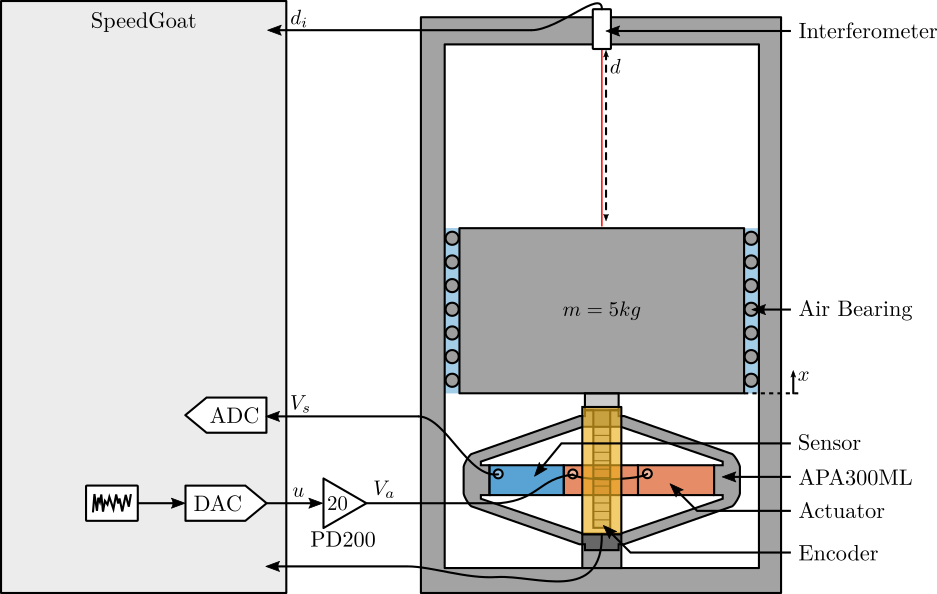
Measurement Procedure
<<sec:measurement_procedure>>
Introduction ignore
Stroke Measurement
Using the PD200 amplifier, output a voltage: \[ V_a = 65 + 85 \sin(2\pi \cdot t) \] To have a quasi-static excitation between -20 and 150V.
As the gain of the PD200 amplifier is 20, the DAC output voltage should be: \[ V_{dac}(t) = 3.25 + 4.25\sin(2\pi \cdot t) \]
Verify that the voltage offset of the PD200 is zero!
Measure the output vertical displacement $d$ using the interferometer.
Then, plot $d$ as a function of $V_a$, and perform a linear regression. Conclude on the obtained stroke.
Stiffness Measurement
Add some (known) weight $\delta m g$ on the suspended mass and measure the deflection $\delta d$. This can be tested when the piezoelectric stacks are open-circuit.
As the stiffness will be around $k \approx 10^6 N/m$, an added mass of $m \approx 100g$ will induce a static deflection of $\approx 1\mu m$ which should be large enough for a precise measurement using the interferometer.
Then the obtained stiffness is:
\begin{equation} k = \frac{\delta m g}{\delta d} \end{equation}Hysteresis measurement
Supply a quasi static sinusoidal excitation $V_a$ at different voltages.
The offset should be 65V, and the sin amplitude can range from 1V up to 85V.
For each excitation amplitude, the vertical displacement $d$ of the mass is measured.
Then, $d$ is plotted as a function of $V_a$ for all the amplitudes.
Piezoelectric Actuator Constant
Using the measurement test-bench, it is rather easy the determine the static gain between the applied voltage $V_a$ to the induced displacement $d$. Use a quasi static (1Hz) excitation signal $V_a$ on the piezoelectric stack and measure the vertical displacement $d$. Perform a linear regression to obtain:
\begin{equation} d = g_{d/V_a} \cdot V_a \end{equation}Using the Simscape model of the APA, it is possible to determine the static gain between the actuator force $F_a$ to the induced displacement $d$:
\begin{equation} d = g_{d/F_a} \cdot F_a \end{equation}From the two gains, it is then easy to determine $g_a$:
\begin{equation} g_a = \frac{F_a}{V_a} = \frac{F_a}{d} \cdot \frac{d}{V_a} = \frac{g_{d/V_a}}{g_{d/F_a}} \end{equation}Piezoelectric Sensor Constant
From a quasi static excitation of the piezoelectric stack, measure the gain from $V_a$ to $V_s$:
\begin{equation} V_s = g_{V_s/V_a} V_a \end{equation}Note here that there is an high pass filter formed by the piezo capacitor and parallel resistor. The excitation frequency should then be in between the cut-off frequency of this high pass filter and the first resonance.
Alternatively, the gain can be computed from the dynamical identification and taking the gain at the wanted frequency.
Using the simscape model, compute the static gain from the actuator force $F_a$ to the strain of the sensor stack $dl$:
\begin{equation} dl = g_{dl/F_a} F_a \end{equation}Then, the static gain from the sensor stack strain $dl$ to the general voltage $V_s$ is:
\begin{equation} g_s = \frac{V_s}{dl} = \frac{V_s}{V_a} \cdot \frac{V_a}{F_a} \cdot \frac{F_a}{dl} = \frac{g_{V_s/V_a}}{g_a \cdot g_{dl/F_a}} \end{equation}Alternatively, we could impose an external force to add strain in the APA that should be equally present in all the 3 stacks and equal to 1/5 of the vertical strain. This external force can be some weight added, or a piezo in parallel.
Capacitance Measurement
Measure the capacitance of the 3 stacks individually using a precise multi-meter.
Dynamical Behavior
Perform a system identification from $V_a$ to the measured displacement $d$ by the interferometer and by the encoder, and to the generated voltage $V_s$.
This can be performed using different excitation signals.
This can also be performed with and without the encoder fixed to the APA.
Compare the results obtained for all 7 APA300ML
Compare all the obtained parameters for all the test APA.
FRF measurement
Introduction ignore
- Schematic of the measurement
| Variable | Unit | Hardware | |
|---|---|---|---|
Va |
Output DAC voltage | [V] | DAC - Ch. 1 => PD200 => APA |
Vs |
Measured stack voltage (ADC) | [V] | APA => ADC - Ch. 1 |
de |
Encoder Measurement | [m] | PEPU Ch. 1 - IO318(1) - Ch. 1 |
da |
Attocube Measurement | [m] | PEPU Ch. 2 - IO318(1) - Ch. 2 |
t |
Time | [s] |
frf_setup.m - Measurement Setup
First is defined the sampling frequency:
%% Simulation configuration
Fs = 10e3; % Sampling Frequency [Hz]
Ts = 1/Fs; % Sampling Time [s]%% Data record configuration
Trec_start = 5; % Start time for Recording [s]
Trec_dur = 100; % Recording Duration [s]Tsim = 2*Trec_start + Trec_dur; % Simulation Time [s]The maximum excitation voltage at resonance is 9Vrms, therefore corresponding to 0.6V of output DAC voltage.
%% Sweep Sine
gc = 0.1;
xi = 0.5;
wn = 2*pi*94.3;
% Notch filter at the resonance of the APA
G_sweep = 0.2*(s^2 + 2*gc*xi*wn*s + wn^2)/(s^2 + 2*xi*wn*s + wn^2);
V_sweep = generateSweepExc('Ts', Ts, ...
'f_start', 10, ...
'f_end', 1e3, ...
'V_mean', 3.25, ...
't_start', Trec_start, ...
'exc_duration', Trec_dur, ...
'sweep_type', 'log', ...
'V_exc', G_sweep*1/(1 + s/2/pi/500));A white noise excitation signal can be very useful in order to obtain a first idea of the plant FRF. The gain can be gradually increased until satisfactory output is obtained.
%% Shaped Noise
V_noise = generateShapedNoise('Ts', 1/Fs, ...
'V_mean', 3.25, ...
't_start', Trec_start, ...
'exc_duration', Trec_dur, ...
'smooth_ends', true, ...
'V_exc', 0.05/(1 + s/2/pi/10));%% Sinus excitation with increasing amplitude
V_sin = generateSinIncreasingAmpl('Ts', 1/Fs, ...
'V_mean', 3.25, ...
'sin_ampls', [0.1, 0.2, 0.4, 1, 2, 4], ...
'sin_period', 1, ...
'sin_num', 5, ...
't_start', 10, ...
'smooth_ends', true);Then, we select the wanted excitation signal.
%% Select the excitation signal
V_exc = timeseries(V_noise(2,:), V_noise(1,:));%% Save data that will be loaded in the Simulink file
save('./frf_data.mat', 'Fs', 'Ts', 'Tsim', 'Trec_start', 'Trec_dur', 'V_exc');
frf_save.m - Save Data
First, we get data from the Speedgoat:
tg = slrt;
f = SimulinkRealTime.openFTP(tg);
mget(f, 'data/data.dat');
close(f);And we load the data on the Workspace:
data = SimulinkRealTime.utils.getFileScopeData('data/data.dat').data;
da = data(:, 1); % Excitation Voltage (input of PD200) [V]
de = data(:, 2); % Measured voltage (force sensor) [V]
Vs = data(:, 3); % Measurment displacement (encoder) [m]
Va = data(:, 4); % Measurement displacement (attocube) [m]
t = data(:, end); % Time [s]
And we save this to a mat file:
apa_number = 1;
save(sprintf('mat/frf_data_%i_huddle.mat', apa_number), 't', 'Va', 'Vs', 'de', 'da');Measurements on APA 1
Introduction ignore
Measurements are first performed on the APA number 1.
Huddle Test
load(sprintf('frf_data_%i_huddle.mat', 1), 't', 'Va', 'Vs', 'de', 'da');%% Parameter for Spectral analysis
Ts = (t(end) - t(1))/(length(t)-1);
Fs = 1/Ts;
win = hanning(ceil(10*Fs)); % Hannning Windows[phh_da, f] = pwelch(da - mean(da), win, [], [], 1/Ts);
[phh_de, ~] = pwelch(de - mean(de), win, [], [], 1/Ts);
[phh_Vs, ~] = pwelch(Vs - mean(Vs), win, [], [], 1/Ts);First identification with Noise
load(sprintf('mat/frf_data_%i_noise.mat', 1), 't', 'Va', 'Vs', 'da', 'de')[pxx_da, f] = pwelch(da, win, [], [], 1/Ts);
[pxx_de, ~] = pwelch(de, win, [], [], 1/Ts);
[pxx_Vs, ~] = pwelch(Vs, win, [], [], 1/Ts);[G_dvf, f] = tfestimate(Va, de, win, [], [], 1/Ts);
[G_d, ~] = tfestimate(Va, da, win, [], [], 1/Ts);
[G_iff, ~] = tfestimate(Va, Vs, win, [], [], 1/Ts);
[coh_dvf, ~] = mscohere(Va, de, win, [], [], 1/Ts);
[coh_d, ~] = mscohere(Va, da, win, [], [], 1/Ts);
[coh_iff, ~] = mscohere(Va, Vs, win, [], [], 1/Ts);Second identification with Sweep
load(sprintf('mat/frf_data_%i_sweep.mat', 1), 't', 'Va', 'Vs', 'da', 'de')[pxx_da, f] = pwelch(da, win, [], [], 1/Ts);
[pxx_de, ~] = pwelch(de, win, [], [], 1/Ts);
[pxx_Vs, ~] = pwelch(Vs, win, [], [], 1/Ts);[G_dvf, f] = tfestimate(Va, de, win, [], [], 1/Ts);
[G_d, ~] = tfestimate(Va, da, win, [], [], 1/Ts);
[G_iff, ~] = tfestimate(Va, Vs, win, [], [], 1/Ts);
[coh_dvf, ~] = mscohere(Va, de, win, [], [], 1/Ts);
[coh_d, ~] = mscohere(Va, da, win, [], [], 1/Ts);
[coh_iff, ~] = mscohere(Va, Vs, win, [], [], 1/Ts);Extract Parameters
Quasi static gain between $d$ and $V_a$:
g_d_Va = mean(abs(G_dvf(f > 10 & f < 15)));g_d_Va = 1.7e-05 [m/V]
Quasi static gain between $V_s$ and $V_a$:
g_Vs_Va = mean(abs(G_iff(f > 10 & f < 15)));g_Vs_Va = 5.7e-01 [V/V]
Comparison of all APA
Test with one APA
%% Load measurement data for APA number 1
load(sprintf('mat/frf_data_%i.mat', 1), 't', 'Va', 'Vs', 'de', 'da');Time domain data:
figure;
plot(t, de);Compute transfer functions:
Ts = (t(end) - t(1))/(length(t)-1);
Fs = 1/Ts;
win = hanning(ceil(0.5*Fs)); % Hannning Windows[G_dvf, f] = tfestimate(Va, de, win, [], [], 1/Ts);
[G_d, ~] = tfestimate(Va, da, win, [], [], 1/Ts);
[G_iff, ~] = tfestimate(Va, Vs, win, [], [], 1/Ts);Comparison of all APA
Measurement Results
Test Bench APA300ML - Simscape Model
Introduction
Nano Hexapod object
n_hexapod = struct();APA - 2 DoF
n_hexapod.actuator = struct();
n_hexapod.actuator.type = 1;
n_hexapod.actuator.k = ones(6,1)*0.35e6; % [N/m]
n_hexapod.actuator.ke = ones(6,1)*1.5e6; % [N/m]
n_hexapod.actuator.ka = ones(6,1)*43e6; % [N/m]
n_hexapod.actuator.c = ones(6,1)*3e1; % [N/(m/s)]
n_hexapod.actuator.ce = ones(6,1)*1e1; % [N/(m/s)]
n_hexapod.actuator.ca = ones(6,1)*1e1; % [N/(m/s)]
n_hexapod.actuator.Leq = ones(6,1)*0.056; % [m]
n_hexapod.actuator.Ga = ones(6,1)*1; % Actuator gain [N/V]
n_hexapod.actuator.Gs = ones(6,1)*1; % Sensor gain [V/m]APA - Flexible Frame
n_hexapod.actuator.type = 2;
n_hexapod.actuator.K = readmatrix('APA300ML_b_mat_K.CSV'); % Stiffness Matrix
n_hexapod.actuator.M = readmatrix('APA300ML_b_mat_M.CSV'); % Mass Matrix
n_hexapod.actuator.xi = 0.01; % Damping ratio
n_hexapod.actuator.P = extractNodes('APA300ML_b_out_nodes_3D.txt'); % Node coordinates [m]
n_hexapod.actuator.ks = 235e6; % Stiffness of one stack [N/m]
n_hexapod.actuator.cs = 1e1; % Stiffness of one stack [N/m]
n_hexapod.actuator.Ga = ones(6,1)*1; % Actuator gain [N/V]
n_hexapod.actuator.Gs = ones(6,1)*1; % Sensor gain [V/m]APA - Fully Flexible
n_hexapod.actuator.type = 3;
n_hexapod.actuator.K = readmatrix('APA300ML_full_mat_K.CSV'); % Stiffness Matrix
n_hexapod.actuator.M = readmatrix('APA300ML_full_mat_M.CSV'); % Mass Matrix
n_hexapod.actuator.xi = 0.01; % Damping ratio
n_hexapod.actuator.P = extractNodes('APA300ML_full_out_nodes_3D.txt'); % Node coordiantes [m]
n_hexapod.actuator.Ga = ones(6,1)*1; % Actuator gain [N/V]
n_hexapod.actuator.Gs = ones(6,1)*1; % Sensor gain [V/m]Identification
%% Options for Linearized
options = linearizeOptions;
options.SampleTime = 0;
%% Name of the Simulink File
mdl = 'test_bench_apa300ml';
%% Input/Output definition
clear io; io_i = 1;
io(io_i) = linio([mdl, '/Va'], 1, 'openinput'); io_i = io_i + 1; % Actuator Voltage
io(io_i) = linio([mdl, '/Vs'], 1, 'openoutput'); io_i = io_i + 1; % Sensor Voltage
io(io_i) = linio([mdl, '/dL'], 1, 'openoutput'); io_i = io_i + 1; % Relative Motion Outputs
io(io_i) = linio([mdl, '/z'], 1, 'openoutput'); io_i = io_i + 1; % Vertical Motion
%% Run the linearization
Ga = linearize(mdl, io, 0.0, options);
Ga.InputName = {'Va'};
Ga.OutputName = {'Vs', 'dL', 'z'};Compare 2-DoF with flexible
APA - 2 DoF
n_hexapod = struct();
n_hexapod.actuator = struct();
n_hexapod.actuator.type = 1;
n_hexapod.actuator.k = ones(6,1)*0.35e6; % [N/m]
n_hexapod.actuator.ke = ones(6,1)*1.5e6; % [N/m]
n_hexapod.actuator.ka = ones(6,1)*43e6; % [N/m]
n_hexapod.actuator.c = ones(6,1)*3e1; % [N/(m/s)]
n_hexapod.actuator.ce = ones(6,1)*1e1; % [N/(m/s)]
n_hexapod.actuator.ca = ones(6,1)*1e1; % [N/(m/s)]
n_hexapod.actuator.Leq = ones(6,1)*0.056; % [m]
n_hexapod.actuator.Ga = ones(6,1)*-2.15; % Actuator gain [N/V]
n_hexapod.actuator.Gs = ones(6,1)*2.305e-08; % Sensor gain [V/m]G_2dof = linearize(mdl, io, 0.0, options);
G_2dof.InputName = {'Va'};
G_2dof.OutputName = {'Vs', 'dL', 'z'};APA - Fully Flexible
n_hexapod = struct();
n_hexapod.actuator.type = 3;
n_hexapod.actuator.K = readmatrix('APA300ML_full_mat_K.CSV'); % Stiffness Matrix
n_hexapod.actuator.M = readmatrix('APA300ML_full_mat_M.CSV'); % Mass Matrix
n_hexapod.actuator.xi = 0.01; % Damping ratio
n_hexapod.actuator.P = extractNodes('APA300ML_full_out_nodes_3D.txt'); % Node coordiantes [m]
n_hexapod.actuator.Ga = ones(6,1)*1; % Actuator gain [N/V]
n_hexapod.actuator.Gs = ones(6,1)*1; % Sensor gain [V/m]G_flex = linearize(mdl, io, 0.0, options);
G_flex.InputName = {'Va'};
G_flex.OutputName = {'Vs', 'dL', 'z'};Comparison
Test Bench Struts - Simscape Model
Introduction
Nano Hexapod object
n_hexapod = struct();Flexible Joint - Bot
n_hexapod.flex_bot = struct();
n_hexapod.flex_bot.type = 1; % 1: 2dof / 2: 3dof / 3: 4dof
n_hexapod.flex_bot.kRx = ones(6,1)*5; % X bending stiffness [Nm/rad]
n_hexapod.flex_bot.kRy = ones(6,1)*5; % Y bending stiffness [Nm/rad]
n_hexapod.flex_bot.kRz = ones(6,1)*260; % Torsionnal stiffness [Nm/rad]
n_hexapod.flex_bot.kz = ones(6,1)*1e8; % Axial stiffness [N/m]
n_hexapod.flex_bot.cRx = ones(6,1)*0.1; % [Nm/(rad/s)]
n_hexapod.flex_bot.cRy = ones(6,1)*0.1; % [Nm/(rad/s)]
n_hexapod.flex_bot.cRz = ones(6,1)*0.1; % [Nm/(rad/s)]
n_hexapod.flex_bot.cz = ones(6,1)*1e2; %[N/(m/s)]Flexible Joint - Top
n_hexapod.flex_top = struct();
n_hexapod.flex_top.type = 2; % 1: 2dof / 2: 3dof / 3: 4dof
n_hexapod.flex_top.kRx = ones(6,1)*5; % X bending stiffness [Nm/rad]
n_hexapod.flex_top.kRy = ones(6,1)*5; % Y bending stiffness [Nm/rad]
n_hexapod.flex_top.kRz = ones(6,1)*260; % Torsionnal stiffness [Nm/rad]
n_hexapod.flex_top.kz = ones(6,1)*1e8; % Axial stiffness [N/m]
n_hexapod.flex_top.cRx = ones(6,1)*0.1; % [Nm/(rad/s)]
n_hexapod.flex_top.cRy = ones(6,1)*0.1; % [Nm/(rad/s)]
n_hexapod.flex_top.cRz = ones(6,1)*0.1; % [Nm/(rad/s)]
n_hexapod.flex_top.cz = ones(6,1)*1e2; %[N/(m/s)]APA - 2 DoF
n_hexapod.actuator = struct();
n_hexapod.actuator.type = 1;
n_hexapod.actuator.k = ones(6,1)*0.35e6; % [N/m]
n_hexapod.actuator.ke = ones(6,1)*1.5e6; % [N/m]
n_hexapod.actuator.ka = ones(6,1)*43e6; % [N/m]
n_hexapod.actuator.c = ones(6,1)*3e1; % [N/(m/s)]
n_hexapod.actuator.ce = ones(6,1)*1e1; % [N/(m/s)]
n_hexapod.actuator.ca = ones(6,1)*1e1; % [N/(m/s)]
n_hexapod.actuator.Leq = ones(6,1)*0.056; % [m]
n_hexapod.actuator.Ga = ones(6,1)*1; % Actuator gain [N/V]
n_hexapod.actuator.Gs = ones(6,1)*1; % Sensor gain [V/m]APA - Flexible Frame
n_hexapod.actuator.type = 2;
n_hexapod.actuator.K = readmatrix('APA300ML_b_mat_K.CSV'); % Stiffness Matrix
n_hexapod.actuator.M = readmatrix('APA300ML_b_mat_M.CSV'); % Mass Matrix
n_hexapod.actuator.xi = 0.01; % Damping ratio
n_hexapod.actuator.P = extractNodes('APA300ML_b_out_nodes_3D.txt'); % Node coordinates [m]
n_hexapod.actuator.ks = 235e6; % Stiffness of one stack [N/m]
n_hexapod.actuator.cs = 1e1; % Stiffness of one stack [N/m]
n_hexapod.actuator.Ga = ones(6,1)*1; % Actuator gain [N/V]
n_hexapod.actuator.Gs = ones(6,1)*1; % Sensor gain [V/m]APA - Fully Flexible
n_hexapod.actuator.type = 3;
n_hexapod.actuator.K = readmatrix('APA300ML_full_mat_K.CSV'); % Stiffness Matrix
n_hexapod.actuator.M = readmatrix('APA300ML_full_mat_M.CSV'); % Mass Matrix
n_hexapod.actuator.xi = 0.01; % Damping ratio
n_hexapod.actuator.P = extractNodes('APA300ML_full_out_nodes_3D.txt'); % Node coordiantes [m]
n_hexapod.actuator.Ga = ones(6,1)*1; % Actuator gain [N/V]
n_hexapod.actuator.Gs = ones(6,1)*1; % Sensor gain [V/m]Identification
%% Options for Linearized
options = linearizeOptions;
options.SampleTime = 0;
%% Name of the Simulink File
mdl = 'test_bench_struts';
%% Input/Output definition
clear io; io_i = 1;
io(io_i) = linio([mdl, '/Va'], 1, 'openinput'); io_i = io_i + 1; % Actuator Voltage
io(io_i) = linio([mdl, '/Vs'], 1, 'openoutput'); io_i = io_i + 1; % Sensor Voltage
io(io_i) = linio([mdl, '/dL'], 1, 'openoutput'); io_i = io_i + 1; % Relative Motion Outputs
io(io_i) = linio([mdl, '/z'], 1, 'openoutput'); io_i = io_i + 1; % Vertical Motion
%% Run the linearization
Gs = linearize(mdl, io, 0.0, options);
Gs.InputName = {'Va'};
Gs.OutputName = {'Vs', 'dL', 'z'};Compare flexible joints
Perfect
n_hexapod.flex_bot.type = 1; % 1: 2dof / 2: 3dof / 3: 4dof
n_hexapod.flex_top.type = 2; % 1: 2dof / 2: 3dof / 3: 4dofGp = linearize(mdl, io, 0.0, options);
Gp.InputName = {'Va'};
Gp.OutputName = {'Vs', 'dL', 'z'};Top Flexible
n_hexapod.flex_bot.type = 1; % 1: 2dof / 2: 3dof / 3: 4dof
n_hexapod.flex_top.type = 3; % 1: 2dof / 2: 3dof / 3: 4dofGt = linearize(mdl, io, 0.0, options);
Gt.InputName = {'Va'};
Gt.OutputName = {'Vs', 'dL', 'z'};Bottom Flexible
n_hexapod.flex_bot.type = 3; % 1: 2dof / 2: 3dof / 3: 4dof
n_hexapod.flex_top.type = 2; % 1: 2dof / 2: 3dof / 3: 4dofGb = linearize(mdl, io, 0.0, options);
Gb.InputName = {'Va'};
Gb.OutputName = {'Vs', 'dL', 'z'};Both Flexible
n_hexapod.flex_bot.type = 3; % 1: 2dof / 2: 3dof / 3: 4dof
n_hexapod.flex_top.type = 3; % 1: 2dof / 2: 3dof / 3: 4dofGf = linearize(mdl, io, 0.0, options);
Gf.InputName = {'Va'};
Gf.OutputName = {'Vs', 'dL', 'z'};Comparison
Resonance frequencies - APA300ML
Introduction
Three main resonances are foreseen to be problematic for the control of the APA300ML:
- Mode in X-bending at 189Hz (Figure fig:mode_bending_x)
- Mode in Y-bending at 285Hz (Figure fig:mode_bending_y)
- Mode in Z-torsion at 400Hz (Figure fig:mode_torsion_z)
These modes are present when flexible joints are fixed to the ends of the APA300ML.
In this section, we try to find the resonance frequency of these modes when one end of the APA is fixed and the other is free.
Setup
The measurement setup is shown in Figure fig:measurement_setup_torsion. A Laser vibrometer is measuring the difference of motion of two points. The APA is excited with an instrumented hammer and the transfer function from the hammer to the measured rotation is computed.
- Laser Doppler Vibrometer Polytec OFV512
- Instrumented hammer
Bending - X
The setup to measure the X-bending motion is shown in Figure fig:measurement_setup_X_bending. The APA is excited with an instrumented hammer having a solid metallic tip. The impact point is on the back-side of the APA aligned with the top measurement point.
The data is loaded.
bending_X = load('apa300ml_bending_X_top.mat');
The config for tfestimate is performed:
Ts = bending_X.Track1_X_Resolution; % Sampling frequency [Hz]
win = hann(ceil(1/Ts));The transfer function from the input force to the output "rotation" (difference between the two measured distances).
[G_bending_X, f] = tfestimate(bending_X.Track1, bending_X.Track2, win, [], [], 1/Ts);The result is shown in Figure fig:apa300ml_meas_freq_bending_x.
The can clearly observe a nice peak at 280Hz, and then peaks at the odd "harmonics" (third "harmonic" at 840Hz, and fifth "harmonic" at 1400Hz).
Bending - Y
The setup to measure the Y-bending is shown in Figure fig:measurement_setup_Y_bending.
The impact point of the instrumented hammer is located on the back surface of the top interface (on the back of the 2 measurements points).
The data is loaded, and the transfer function from the force to the measured rotation is computed.
bending_Y = load('apa300ml_bending_Y_top.mat');
[G_bending_Y, ~] = tfestimate(bending_Y.Track1, bending_Y.Track2, win, [], [], 1/Ts);The results are shown in Figure fig:apa300ml_meas_freq_bending_y. The main resonance is at 412Hz, and we also see the third "harmonic" at 1220Hz.
Torsion - Z
Finally, we measure the Z-torsion resonance as shown in Figure fig:measurement_setup_torsion_bis.
The excitation is shown on the other side of the APA, on the side to excite the torsion motion.
The data is loaded, and the transfer function computed.
torsion = load('apa300ml_torsion_left.mat');
[G_torsion, ~] = tfestimate(torsion.Track1, torsion.Track2, win, [], [], 1/Ts);The results are shown in Figure fig:apa300ml_meas_freq_torsion_z. We observe a first peak at 267Hz, which corresponds to the X-bending mode that was measured at 280Hz. And then a second peak at 415Hz, which corresponds to the X-bending mode that was measured at 412Hz. The mode in pure torsion is probably at higher frequency (peak around 1kHz?).
In order to verify that, the APA is excited on the top part such that the torsion mode should not be excited.
torsion = load('apa300ml_torsion_top.mat');
[G_torsion_top, ~] = tfestimate(torsion.Track1, torsion.Track2, win, [], [], 1/Ts);The two FRF are compared in Figure fig:apa300ml_meas_freq_torsion_z_comp. It is clear that the first two modes does not correspond to the torsional mode. Maybe the resonance at 800Hz, or even higher resonances. It is difficult to conclude here.
Compare
The three measurements are shown in Figure fig:apa300ml_meas_freq_compare.
Conclusion
When two flexible joints are fixed at each ends of the APA, the APA is mostly in a free/free condition in terms of bending/torsion (the bending/torsional stiffness of the joints being very small).
In the current tests, the APA are in a fixed/free condition. Therefore, it is quite obvious that we measured higher resonance frequencies than what is foreseen for the struts. It is however quite interesting that there is a factor $\approx \sqrt{2}$ between the two (increased of the stiffness by a factor 2?).
| Mode | Strut Mode | Measured Frequency |
|---|---|---|
| X-Bending | 189Hz | 280Hz |
| Y-Bending | 285Hz | 410Hz |
| Z-Torsion | 400Hz | ? |
Function
generateSweepExc: Generate sweep sinus excitation
<<sec:generateSweepExc>>
Function description
function [U_exc] = generateSweepExc(args)
% generateSweepExc - Generate a Sweep Sine excitation signal
%
% Syntax: [U_exc] = generateSweepExc(args)
%
% Inputs:
% - args - Optinal arguments:
% - Ts - Sampling Time - [s]
% - f_start - Start frequency of the sweep - [Hz]
% - f_end - End frequency of the sweep - [Hz]
% - V_mean - Mean value of the excitation voltage - [V]
% - V_exc - Excitation Amplitude for the Sweep, could be numeric or TF - [V]
% - t_start - Time at which the sweep begins - [s]
% - exc_duration - Duration of the sweep - [s]
% - sweep_type - 'logarithmic' or 'linear' - [-]
% - smooth_ends - 'true' or 'false': smooth transition between 0 and V_mean - [-]Optional Parameters
arguments
args.Ts (1,1) double {mustBeNumeric, mustBePositive} = 1e-4
args.f_start (1,1) double {mustBeNumeric, mustBePositive} = 1
args.f_end (1,1) double {mustBeNumeric, mustBePositive} = 1e3
args.V_mean (1,1) double {mustBeNumeric} = 0
args.V_exc = 1
args.t_start (1,1) double {mustBeNumeric, mustBeNonnegative} = 5
args.exc_duration (1,1) double {mustBeNumeric, mustBePositive} = 10
args.sweep_type char {mustBeMember(args.sweep_type,{'log', 'lin'})} = 'lin'
args.smooth_ends logical {mustBeNumericOrLogical} = true
endSweep Sine part
t_sweep = 0:args.Ts:args.exc_duration;
if strcmp(args.sweep_type, 'log')
V_exc = sin(2*pi*args.f_start * args.exc_duration/log(args.f_end/args.f_start) * (exp(log(args.f_end/args.f_start)*t_sweep/args.exc_duration) - 1));
elseif strcmp(args.sweep_type, 'lin')
V_exc = sin(2*pi*(args.f_start + (args.f_end - args.f_start)/2/args.exc_duration*t_sweep).*t_sweep);
else
error('sweep_type should either be equal to "log" or to "lin"');
endif isnumeric(args.V_exc)
V_sweep = args.V_mean + args.V_exc*V_exc;
elseif isct(args.V_exc)
if strcmp(args.sweep_type, 'log')
V_sweep = args.V_mean + abs(squeeze(freqresp(args.V_exc, args.f_start*(args.f_end/args.f_start).^(t_sweep/args.exc_duration), 'Hz')))'.*V_exc;
elseif strcmp(args.sweep_type, 'lin')
V_sweep = args.V_mean + abs(squeeze(freqresp(args.V_exc, args.f_start+(args.f_end-args.f_start)/args.exc_duration*t_sweep, 'Hz')))'.*V_exc;
end
endSmooth Ends
if args.t_start > 0
t_smooth_start = args.Ts:args.Ts:args.t_start;
V_smooth_start = zeros(size(t_smooth_start));
V_smooth_end = zeros(size(t_smooth_start));
if args.smooth_ends
Vd_max = args.V_mean/(0.7*args.t_start);
V_d = zeros(size(t_smooth_start));
V_d(t_smooth_start < 0.2*args.t_start) = t_smooth_start(t_smooth_start < 0.2*args.t_start)*Vd_max/(0.2*args.t_start);
V_d(t_smooth_start > 0.2*args.t_start & t_smooth_start < 0.7*args.t_start) = Vd_max;
V_d(t_smooth_start > 0.7*args.t_start & t_smooth_start < 0.9*args.t_start) = Vd_max - (t_smooth_start(t_smooth_start > 0.7*args.t_start & t_smooth_start < 0.9*args.t_start) - 0.7*args.t_start)*Vd_max/(0.2*args.t_start);
V_smooth_start = cumtrapz(V_d)*args.Ts;
V_smooth_end = args.V_mean - V_smooth_start;
end
else
V_smooth_start = [];
V_smooth_end = [];
endCombine Excitation signals
V_exc = [V_smooth_start, V_sweep, V_smooth_end];
t_exc = args.Ts*[0:1:length(V_exc)-1];U_exc = [t_exc; V_exc];
generateShapedNoise: Generate Shaped Noise excitation
<<sec:generateShapedNoise>>
Function description
function [U_exc] = generateShapedNoise(args)
% generateShapedNoise - Generate a Shaped Noise excitation signal
%
% Syntax: [U_exc] = generateShapedNoise(args)
%
% Inputs:
% - args - Optinal arguments:
% - Ts - Sampling Time - [s]
% - V_mean - Mean value of the excitation voltage - [V]
% - V_exc - Excitation Amplitude, could be numeric or TF - [V rms]
% - t_start - Time at which the noise begins - [s]
% - exc_duration - Duration of the noise - [s]
% - smooth_ends - 'true' or 'false': smooth transition between 0 and V_mean - [-]Optional Parameters
arguments
args.Ts (1,1) double {mustBeNumeric, mustBePositive} = 1e-4
args.V_mean (1,1) double {mustBeNumeric} = 0
args.V_exc = 1
args.t_start (1,1) double {mustBeNumeric, mustBePositive} = 5
args.exc_duration (1,1) double {mustBeNumeric, mustBePositive} = 10
args.smooth_ends logical {mustBeNumericOrLogical} = true
endShaped Noise
t_noise = 0:args.Ts:args.exc_duration;if isnumeric(args.V_exc)
V_noise = args.V_mean + args.V_exc*sqrt(1/args.Ts/2)*randn(length(t_noise), 1)';
elseif isct(args.V_exc)
V_noise = args.V_mean + lsim(args.V_exc, sqrt(1/args.Ts/2)*randn(length(t_noise), 1), t_noise)';
endSmooth Ends
t_smooth_start = args.Ts:args.Ts:args.t_start;
V_smooth_start = zeros(size(t_smooth_start));
V_smooth_end = zeros(size(t_smooth_start));
if args.smooth_ends
Vd_max = args.V_mean/(0.7*args.t_start);
V_d = zeros(size(t_smooth_start));
V_d(t_smooth_start < 0.2*args.t_start) = t_smooth_start(t_smooth_start < 0.2*args.t_start)*Vd_max/(0.2*args.t_start);
V_d(t_smooth_start > 0.2*args.t_start & t_smooth_start < 0.7*args.t_start) = Vd_max;
V_d(t_smooth_start > 0.7*args.t_start & t_smooth_start < 0.9*args.t_start) = Vd_max - (t_smooth_start(t_smooth_start > 0.7*args.t_start & t_smooth_start < 0.9*args.t_start) - 0.7*args.t_start)*Vd_max/(0.2*args.t_start);
V_smooth_start = cumtrapz(V_d)*args.Ts;
V_smooth_end = args.V_mean - V_smooth_start;
endCombine Excitation signals
V_exc = [V_smooth_start, V_noise, V_smooth_end];
t_exc = args.Ts*[0:1:length(V_exc)-1];U_exc = [t_exc; V_exc];
generateSinIncreasingAmpl: Generate Sinus with increasing amplitude
<<sec:generateSinIncreasingAmpl>>
Function description
function [U_exc] = generateSinIncreasingAmpl(args)
% generateSinIncreasingAmpl - Generate Sinus with increasing amplitude
%
% Syntax: [U_exc] = generateSinIncreasingAmpl(args)
%
% Inputs:
% - args - Optinal arguments:
% - Ts - Sampling Time - [s]
% - V_mean - Mean value of the excitation voltage - [V]
% - sin_ampls - Excitation Amplitudes - [V]
% - sin_freq - Excitation Frequency - [Hz]
% - sin_num - Number of period for each amplitude - [-]
% - t_start - Time at which the excitation begins - [s]
% - smooth_ends - 'true' or 'false': smooth transition between 0 and V_mean - [-]Optional Parameters
arguments
args.Ts (1,1) double {mustBeNumeric, mustBePositive} = 1e-4
args.V_mean (1,1) double {mustBeNumeric} = 0
args.sin_ampls double {mustBeNumeric, mustBePositive} = [0.1, 0.2, 0.3]
args.sin_period (1,1) double {mustBeNumeric, mustBePositive} = 1
args.sin_num (1,1) double {mustBeNumeric, mustBePositive, mustBeInteger} = 3
args.t_start (1,1) double {mustBeNumeric, mustBePositive} = 5
args.smooth_ends logical {mustBeNumericOrLogical} = true
endSinus excitation
t_noise = 0:args.Ts:args.sin_period*args.sin_num;
sin_exc = [];for sin_ampl = args.sin_ampls
sin_exc = [sin_exc, args.V_mean + sin_ampl*sin(2*pi/args.sin_period*t_noise)];
endSmooth Ends
t_smooth_start = args.Ts:args.Ts:args.t_start;
V_smooth_start = zeros(size(t_smooth_start));
V_smooth_end = zeros(size(t_smooth_start));
if args.smooth_ends
Vd_max = args.V_mean/(0.7*args.t_start);
V_d = zeros(size(t_smooth_start));
V_d(t_smooth_start < 0.2*args.t_start) = t_smooth_start(t_smooth_start < 0.2*args.t_start)*Vd_max/(0.2*args.t_start);
V_d(t_smooth_start > 0.2*args.t_start & t_smooth_start < 0.7*args.t_start) = Vd_max;
V_d(t_smooth_start > 0.7*args.t_start & t_smooth_start < 0.9*args.t_start) = Vd_max - (t_smooth_start(t_smooth_start > 0.7*args.t_start & t_smooth_start < 0.9*args.t_start) - 0.7*args.t_start)*Vd_max/(0.2*args.t_start);
V_smooth_start = cumtrapz(V_d)*args.Ts;
V_smooth_end = args.V_mean - V_smooth_start;
endCombine Excitation signals
V_exc = [V_smooth_start, sin_exc, V_smooth_end];
t_exc = args.Ts*[0:1:length(V_exc)-1];U_exc = [t_exc; V_exc];